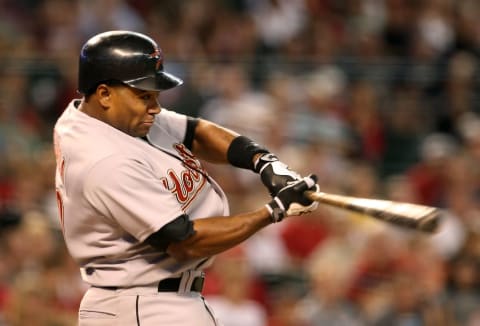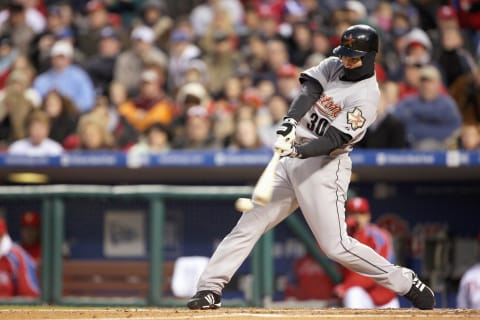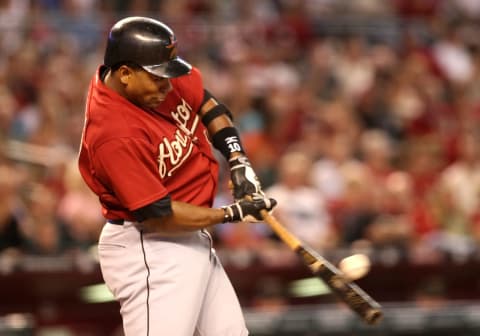Astros: Reviewing the 2007 Miguel Tejada trade with Orioles

We look back at the 2007 trade bringing Miguel Tejada to the Houston Astros.
The Houston Astros reached the World Series in 2005 and narrowly missed the postseason in 2006, so there were plenty of expectations for the 2007 season. Unfortunately the team went 73-89, costing manager Phil Garner and GM Tim Purpura their jobs. Looking to rebound in 2008, new GM Ed Wade made a blockbuster trade for shortstop Miguel Tejada.
Wade made a few big deals that offseason, shipping Brad Lidge to the Phillies (and acquiring the underrated Michael Bourn), bringing Jose Valverde in from Arizona and signing Kazuo Matsui. But perhaps the biggest was on Dec. 12 when he acquired Tejada in exchange for pitchers Matt Albers, Troy Patton and Dennis Sarfate, outfielder Luke Scott and third baseman Mike Costanzo.
The Astros had coveted Tejada for some time and finally got him to Houston. They gave up five players to get him, so they paid a handsome price for a 33-year-old former MVP. But was the trade worthwhile? Let’s take a look in depth.

What the Astros Got
The Astros got Tejada, who provided a big upgrade offensively over their previous shortstop Adam Everett. He was also solid defensively, though not as exceptional as Everett in that regard. Still, there’s no doubt the team got better by adding Tejada to the mix.
He was a four-time All-Star and one of the most durable players in the game, having appeared in 159 or more games in eight straight seasons, including playing in all 162 in six straight seasons from 2001 through 2006. He also was a two-time Silver Slugger winner and had received MVP consideration six times.
He broke in with Oakland in 1997 and provided 22.1 WAR over seven seasons, including winning the AL MVP award in 2002. He left for Baltimore via free agency after the 2003 season and was worth 19.5 WAR in five seasons. Tejada totaled a major league-best 150 RBIs in 2004, his fifth straight season of 100 or more RBIs, and hit .330 in 2006. His 2007 season, however, saw a slight decline, as he hit just 19 doubles, 18 homers and 81 RBIs in 133 games.
In his first year with the Astros, he hit .283/.314/.415 with 38 doubles, 13 homers and 66 RBIs. His home run, RBI, on-base and slugging marks were his worst since 1998. He also grounded into a major league-high 32 double plays, though he did make his fifth All-Star team.
Tejada’s second year in Houston was better. He hit .313/.340/.455 with 14 homers, 86 RBIs and a league-leading 46 doubles. He left via free agency after those two seasons, having provided a total of 3.8 WAR for the Astros. Though his power had largely disappeared, he played in 158 games each season, though the team managed only 86 wins in 2008 and 74 wins in 2009.

What the Astros Gave Up
Scott was the most established player going to Baltimore. He hit .336/.426/.621 in 65 games in 2006 and .255/.351/.504 with 28 doubles and 18 homers in 132 games in 2007, providing the Astros with 3.5 WAR over three seasons.
He continued to hit well in Baltimore, compiling a .260/.342/.485 line with 95 doubles and 84 homers in four seasons and totaling 7.9 WAR. He left via free agency and spent his last two seasons with the Rays, totaling 0.5 WAR in those two campaigns.
Albers broke into the majors in 2006 and got his first extended major league action in 2007, going 4-11 with a 5.86 ERA in 18 starts and 13 relief appearances for the Astros. He pitched almost entirely out of the bullpen in Baltimore, compiling a 4.60 ERA in three seasons. He’s played for eight teams in his up-and-down career thus far, including another brief stint in Houston in 2014.
Patton, who was a Houston-area native like Albers, made a brief major league debut with the Astros in 2007. The left-hander was a top prospect, but suffered a torn labrum in early 2008 and would not return to the majors until 2010, when he made just one appearance. He pitched effectively out of the Orioles’ bullpen for the next three seasons before being traded to the Padres in 2014.
Patton had issues with failing drug tests, as he failed one in 2010 and another in late 2013, which resulted in a 25-game suspension in 2014. He once again tested positive for an amphetamine in late 2014 and received an 80-game suspension, though he did not see the majors again. He played for the Royals’ Triple-A club in 2015, and that was his last appearance.
Sarfate made seven relief appearances with the Astros in 2007, allowing one run in 8.1 innings. He pitched for the Orioles for two seasons, working to a combined 4.82 ERA in four starts and 73 relief appearances, as he had difficulty limiting free passes.
Costanzo never played in the majors with either team. He came to the Astros in the Lidge trade, so he was only with the organization for a little more than a month. He reached the majors in 2012 with the Reds, appearing in 17 games and compiling just one single, one walk and two sacrifice flies in 21 plate appearances. That would be the entirety of his major league career.

The Final Verdict
We’ll start with a strict on-field interpretation. The Astros got 3.8 WAR from Tejada over two seasons. The Orioles got 3.5 WAR from Scott, 2.8 from Patton, 0.9 from Albers and 0.1 from Sarfate, for a total of 7.3 WAR. So in that sense, the Orioles came out ahead.
However, it’s hard to say they got their expected value from anyone aside from Scott. He was a slightly above-average hitter and below average defender, which was basically his M.O. for his career. Albers didn’t pitch particularly well, Patton only made it as a reliever for three years, and Sarfate and Costanzo basically gave the club nothing at the major league level.
More from Climbing Tal's Hill
- Just how much better is the Houston Astros playoff rotation than the rest?
- Houston Astros: A Lineup Change to Spark Offense
- Astros prospect Hunter Brown throws 6 shutout innings in debut
- Always faithful Astros World Series champion Josh Reddick defends the title
- Michael Conforto declines Astros’ 2-year, $30 million offer
Tejada wasn’t the player he used to be, but he still was above-average offensively and about average on defense, on the whole. The fact that the Astros failed to make the postseason wasn’t his fault, and it’s hard to think they would have done any better if they hadn’t made the trade.
Besides, it was likely ownership’s mandate to try and win. By this point, a rebuild was probably in order, but I doubt Drayton McLane wanted that. Wade was likely hired with the mandate to get the club back into the postseason, and the team did have a decent core of Lance Berkman, Carlos Lee, Hunter Pence and Roy Oswalt. Adding Tejada and Valverde to that mix wasn’t a bad idea.
In the end, the Astros sold high on Patton, which was probably for the best in hindsight. They gave up two young pitchers who would only amount to relievers, plus a solid if unspectacular hitter in Scott, who was without a position thanks to the emergence of Pence and the acquisition of Michael Bourn. In return, they got a player who would make two straight All-Star teams with the club.
So in the end, since the Orioles only really got some decent production from Scott and three solid years of relief from Patton, I’d call this trade a wash. The Astros seemingly gave up a big haul at the time, but Tejada was a solid player and the prospects sent to Baltimore didn’t pan out as expected.